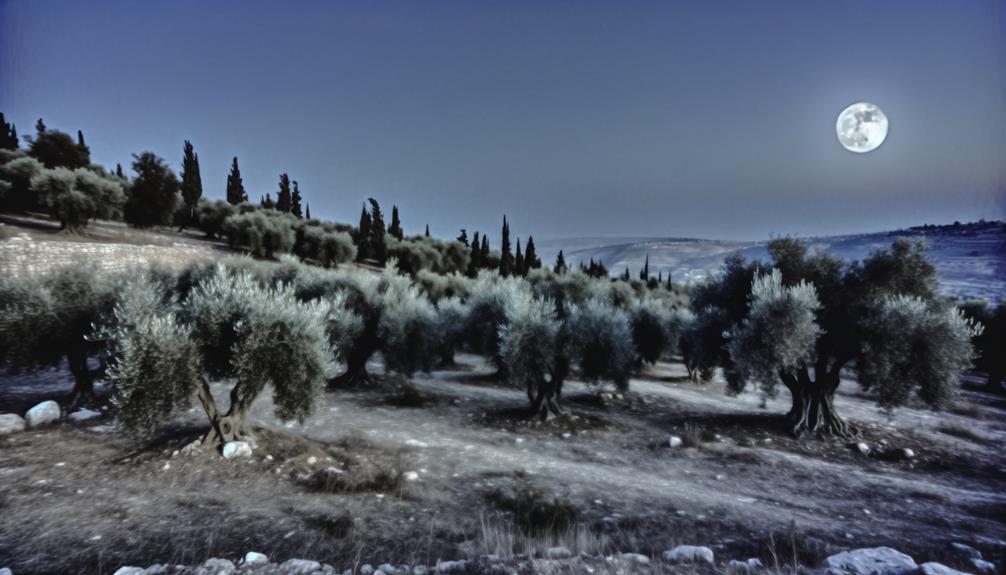Meaning of Gethsemane in the Bible: Place of Suffering
Gethsemane, derived from the Aramaic term meaning ‘oil press,’ is a significant biblical location at the base of the Mount of Olives, often symbolizing intense emotional and spiritual struggle. It is famously known as the site where Jesus, facing His impending crucifixion, prayed fervently to align His will with that of God, uttering, “Not my will, but Yours be done” (Luke 22:42).
This moment encapsulates themes of ultimate sacrifice, divine obedience, and human vulnerability, highlighting the intersection of Christ’s dual nature. To grasp the full implications of this profound narrative, further exploration into scriptural passages and theological reflections is essential.

Biblical Meaning of Gethsemane: Symbolism and Spiritual Lessons
| Aspect | Details |
|---|---|
| Name Meaning | Aramaic origin meaning “oil press” |
| Biblical References | Matthew 26:36–46, Mark 14:32–42, Luke 22:39–46, John 18:1 |
| Spiritual Symbolism | Suffering, surrender, prayer, obedience, divine will |
| Event Significance | Place where Jesus prayed before His arrest and crucifixion |
| Related Bible Concepts | Spiritual warfare, submission to God’s will, preparation for sacrifice |
Historical Context of Gethsemane

Situated at the base of the Mount of Olives, Gethsemane holds profound significance in both historical and theological contexts, serving as the setting for Jesus’ poignant prayers and arrest as recounted in the Gospels.
Historically, Gethsemane, meaning ‘oil press’ in Aramaic, was a garden likely used for olive cultivation and oil production, reflecting the agrarian culture of ancient Jerusalem. The site’s proximity to Jerusalem made it an accessible retreat for Jesus and His disciples.
Scriptural analysis highlights Gethsemane as a place of profound emotional and spiritual turmoil, where Jesus grappled with the impending crucifixion.
This historical context enriches the understanding of Gethsemane’s role in the Passion narrative, emphasizing its enduring spiritual and cultural resonance.
Location and Significance

Gethsemane’s location at the base of the Mount of Olives, within close proximity to Jerusalem, underscores its theological significance as the site where Jesus experienced profound agony and submission to God’s will. This geographical placement is pivotal, symbolizing a liminal space between sacred and secular domains.
The Mount of Olives itself holds deep biblical connections, being a site of eschatological prophecy and divine encounters.
- Proximity to Jerusalem: Enhances its accessibility and relevance in the narrative of Holy Week.
- Symbolic Landscape: Represents a place of testing and divine revelation.
These elements collectively contribute to Gethsemane’s profound spiritual and historical resonance in biblical theology.
Jesus’ Agony and Prayer

In the Garden of Gethsemane, Jesus’ experience of intense emotional distress is poignantly captured in the Gospel accounts, highlighting His profound sorrow and anguish.
This moment underscores His human vulnerability as He prays fervently, seeking strength to embrace the impending crucifixion.
Ultimately, Jesus’ submission to God’s will, encapsulated in His prayer, ‘Not my will, but Yours be done‘ (Luke 22:42), reflects His obedience and the fulfillment of divine purpose.
Intense Emotional Distress
The poignant scene of Jesus’ agony and prayer in the Garden of Gethsemane is a profound illustration of intense emotional distress, capturing a critical moment of vulnerability and divine submission. This episode, documented in the Synoptic Gospels, reveals the depth of Jesus’ anticipation of the forthcoming crucifixion.
- Scriptural References: The Gospels of Matthew (26:36-46), Mark (14:32-42), and Luke (22:39-46) provide detailed accounts of Jesus’ emotional turmoil.
- Historical Context: The garden, located at the foot of the Mount of Olives, was a familiar place of retreat for Jesus and His disciples.
- Theological Significance: Jesus’ sweat, described as ‘like drops of blood’ (Luke 22:44), symbolizes the immense psychological and spiritual anguish He endured.
Submission to God’s Will
Amidst the profound sorrow and apprehension, Jesus’ prayer in Gethsemane epitomizes His unwavering submission to God’s will, as He pleads, ‘Yet not as I will, but as you will’ (Matthew 26:39).
This moment reflects a deep theological significance where Jesus, fully aware of the impending crucifixion, aligns His will with the Father’s. The agony of Gethsemane underscores the human struggle with divine obedience, offering a paradigm of surrender. Jesus’ prayerful submission is a profound act of faith, encapsulating a pivotal moment in salvation history.
| Aspect | Jesus’ Experience | Scriptural Reference |
|---|---|---|
| Emotional Suffering | Deep sorrow and distress | Matthew 26:37-38 |
| Divine Submission | Acceptance of God’s plan | Matthew 26:39 |
| Spiritual Significance | Fulfillment of prophecy | Isaiah 53:10 |
This table elucidates key elements of Jesus’ experience in Gethsemane.
Themes of Sacrifice and Obedience

Central to the narrative of Gethsemane is the profound demonstration of Jesus’ sacrifice and obedience, encapsulating the essence of his mission and the fulfillment of divine will. In this sacred garden, Jesus exemplifies ultimate submission to God’s plan, despite the foreseen torment. This act underscores the themes of sacrificial love and unwavering fidelity to God’s purpose.
- Sacrificial Love: Jesus’ willingness to endure suffering for humanity’s redemption.
- Unwavering Obedience: His prayer, ‘Not my will, but yours be done’ (Luke 22:42), signifies complete submission.
These elements collectively highlight the theological depth of Gethsemane’s narrative.
Gethsemane in Christian Theology

In Christian theology, the Garden of Gethsemane stands as a significant locus for understanding Jesus’ agony prayer, which encapsulates the profound internal struggle between his divine mission and human vulnerability.
This moment is imbued with rich symbolism of suffering, reflecting the ultimate sacrifice and obedience that Christ exemplifies.
Additionally, Gethsemane serves as an essential site of spiritual preparation, where Jesus fortifies himself for the impending Passion, highlighting the necessity of spiritual resilience in the face of adversity.
Jesus’ Agony Prayer
Jesus’ agony in the Garden of Gethsemane, as recorded in the Gospels, stands as a profound moment of theological significance, illustrating His deep human anguish and divine submission to the Father’s will.
In this pivotal scene, Jesus’ prayer reveals His intimate relationship with God and His acceptance of the impending suffering. Theologically, this moment underscores the dual nature of Christ, fully human and fully divine.
- Scriptural Analysis: Jesus’ plea, ‘Let this cup pass from me,’ reflects His human desire to avoid suffering, yet His concluding, ‘Not as I will, but as you will,’ exemplifies ultimate obedience (Matthew 26:39).
- Historical Context: Gethsemane, an olive grove outside Jerusalem, was a place of solitude for Jesus.
- Theological Expertise: This narrative highlights the intersection of divine foreknowledge and human free will.
Symbolism of Suffering
The poignant scene in Gethsemane serves as a powerful symbol of suffering within Christian theology, reflecting the profound depths of human anguish and divine obedience.
Scripturally, Jesus’ prayer in the Garden of Gethsemane (Matthew 26:36-46) is suffused with intense emotional struggle, mirroring the human experience of distress and anticipation of suffering.
Historically, the garden becomes a crucible where Jesus confronts the culmination of His earthly mission, embodying the ultimate act of submission to God’s will.
Theologically, Gethsemane encapsulates the paradox of Christ’s dual nature—fully divine yet fully human—expressing both vulnerability and resolute faith.
This episode, therefore, becomes a profound narrative on the redemptive potential of suffering and the necessity of divine surrender.
Spiritual Preparation Significance
Gethsemane represents a pivotal moment of spiritual preparation in Christian theology, where Jesus’ fervent prayers and agonizing anticipation underscore the profound readiness required to fulfill divine purpose. This episode, chronicled in the Gospels, illuminates the theological depth of Christ’s submission to God’s will, serving as a model for believers’ own spiritual discipline.
- Theological Expertise: Gethsemane exemplifies the human and divine natures of Christ, where His anguish manifests His humanity while His resolve demonstrates divine obedience.
- Historical Context: Situated at the Mount of Olives, Gethsemane is a place of ancient olive presses, symbolizing pressing trials and purification.
- Scriptural Analysis: Luke 22:44 describes Jesus’ sweat like drops of blood, emphasizing the intensity of His preparation and the gravity of His impending sacrifice.
Legacy and Impact on Faith

The agony and prayers of Jesus at Gethsemane profoundly resonate within the Christian faith, symbolizing the ultimate submission to God’s will amidst overwhelming human suffering. This moment encapsulates the theological essence of Christ’s dual nature, being fully divine yet fully human.
Historically, Gethsemane serves as a poignant prelude to the Passion narrative, where Jesus’ fervent prayers reveal both His vulnerability and unwavering obedience. Scriptural analysis of passages like Matthew 26:36-46 and Luke 22:39-46 underscores the depth of Jesus’ anguish and His resolve to fulfill divine purpose.
Consequently, Gethsemane’s legacy endures as a profound reflection of faith, encouraging believers to seek God’s strength and align their wills with His, particularly in times of trial and tribulation.
Conclusion
In sum, the Garden of Gethsemane, a site of historical and spiritual import, has been thoroughly dissected only to reveal the predictable themes of sacrifice and obedience.
Jesus’ agonizing prayer, a cornerstone of Christian theology, serves as a divine reminder: faith is often a paradox of suffering and submission.
The legacy of Gethsemane continues to inspire believers, perhaps because grappling with existential woes is a perennial favorite in theological circles.
Truly, what better pastime than pondering eternal mysteries?






